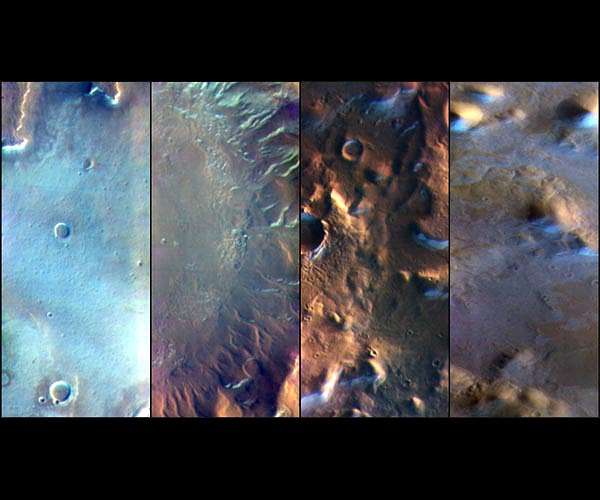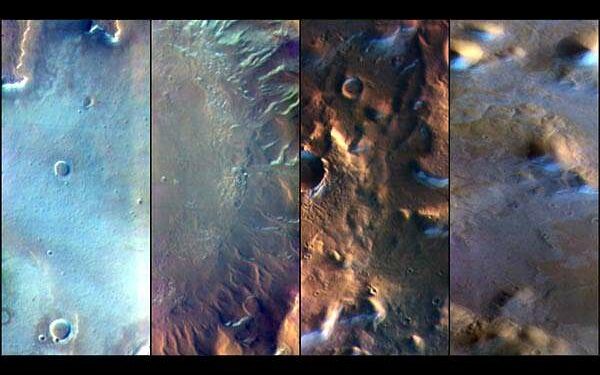
Water frost discovered on Mars’ tallest volcanoes
by Erica Marchand
Paris, France (SPX) Jun 10, 2024
Water frost has been detected on Mars’ colossal volcanoes, marking the first observation of this phenomenon on the largest mountains in the Solar System. The international team, led by the University of Bern, utilized high-resolution color images from the Bernese Mars camera, CaSSIS, onboard the European Space Agency’s ExoMars Trace Gas Orbiter. Understanding water distribution and transport is critical for future Mars missions and potential human exploration.
“ExoMars” is a European Space Agency (ESA) program conducting active research into life on Mars for the first time since the 1970s. On board the ExoMars Trace Gas Orbiter (TGO) is the Colour and Stereo Surface Imaging System (CaSSIS), developed by an international team led by Professor Nicolas Thomas from the University of Bern’s Physics Institute. CaSSIS has been capturing high-resolution color images of Mars’ surface since April 2018.
Using these images, an international team led by Dr. Adomas Valantinas detected water frost on Mars. The study, published in Nature Geoscience, highlights that Valantinas was a PhD student at the University of Bern’s Space Research and Planetary Sciences Department until October 2023 and is now a guest researcher at Brown University, supported by a Swiss National Science Foundation (SNSF) Postdoc.Mobility fellowship.
The frost was found on the Tharsis volcanoes, the tallest mountains in the Solar System, including Olympus Mons, which rises 26 km above the plains. “At these low latitudes, the high amounts of sunshine tend to keep surface temperatures high. Therefore, we did not expect frost to be found there,” said Valantinas. Despite Mars’ thin atmosphere, high altitude surfaces can get as hot as low altitude surfaces at midday.
Valantinas explained that upslope winds bring air with water vapor from the lowlands, cooling as it ascends and causing condensation. This phenomenon, seen on both Earth and Mars, leads to morning frost deposits on the Tharsis volcanoes, which evaporate quickly after sunrise. “As we could see from the CaSSIS images, the thin frosts are only present briefly, for a few hours around sunrise,” Valantinas noted.
To identify the frost, the team analyzed over 5,000 images from the CaSSIS camera. Since April 2018, CaSSIS has observed local dust activity, seasonal changes in CO2 ice deposits, and dry avalanches on Mars. “That we now could detect the nighttime deposition of water frost on Mars at visual wavelengths and at high resolution is yet another proof of the impressive scientific capabilities of the Bern camera system,” said Thomas.
The discovery was validated using observations from the High Resolution Stereo Camera (HRSC) on the ESA Mars Express orbiter and the Nadir and Occultation for Mars Discovery (NOMAD) spectrometer onboard TGO. Ernst Hauber, a geologist at the DLR Institute of Planetary Research in Berlin, said, “This study nicely demonstrates the value of different orbital assets. Combining measurements from various instruments and modelling improves our understanding of atmosphere-surface interactions.”
Despite the frost’s thinness – likely one-hundredth of a millimeter thick – the patches cover a vast area. “The amount of frost represents about 150,000 tonnes of water swapping between surface and atmosphere each day during the cold seasons, the equivalent of roughly 60 Olympic swimming pools,” Valantinas explained.
Understanding water distribution and movement on Mars is crucial for many aspects of Mars exploration, including future human missions. “Of course, we want to understand the physical processes involved in the climate of Mars. But, in addition, understanding the water cycle on Mars is also of major importance for establishing key resources for future human exploration and to constrain the past or present habitability,” Valantinas concluded.
Research Report:Evidence for transient morning water frost deposits on the Tharsis volcanoes of Mars
Related Links
ExoMars
Mars News and Information at MarsDaily.com
Lunar Dreams and more












